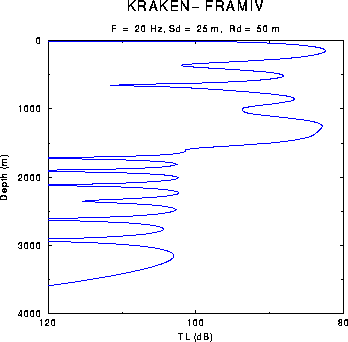
Figure: Sample output of PLOTTLD: transmission loss vs. depth for the Arctic problem.
PLOTTLD produces plots of coherent transmission loss versus depth. The user must provide a mode file as computed by KRAKEN .
Files:
Name Unit Description
Input
*.PLP 1 PLot Parameters
*.MOD 30 MODe file
Output
*.PRT 6 PRinT file
---------------------------------------------------------
EXAMPLE AND DESCRIPTION OF PLP FILE:
'R' ! OPT (X or R for cart or cyl coords)
999 ! M (number of modes to include)
25.0 ! SD (m)
50.0 ! Receiver range (km)
501 0.0 3750.0 / ! NRCVRS RD(1:NRCVRS) (m)
0.0 4000.0 1000.0 10.0 ! ZMIN ZMAX ZINC (m) ZAXL (cm)
70.0 110.0 10.0 10.0 ! TLMIN TLMAX TLINC (dB) TLAXL (cm)
(1) - OPTIONS
Syntax:
OPTION
Description:
OPTION(1:1): Source type.
'R' for a point source
(cylindrical or R-Z coordinates).
'X' for a line source
(cartesian or X-Z coordinates)
OPTION(2:2): Dummy variable for consistency with PLOTTLR.
OPTION(3:3): Component.
'' (null) for pressure.
'H' for Horizontal displacement.
'V' for Vertical displacement.
'T' for Tangential stress.
'N' for Normal stress.
(2) NUMBER OF MODES
Syntax:
M
Description:
M: Number of modes to use in the field calculation.
If this number is larger than the actual number of
modes in the mode file it is reduced accordingly.
(3) - SOURCE/RECEIVER LOCATIONS
Syntax:
SD
RR
NRD RD(1:NRD)
Description:
SD: Source depth (m ).
RR: Receiver range (km).
NRD: Number of receivers.
RD(): Receiver depths (m).
The format of the source/rcvr depth info is an
integer indicating the number of receivers
followed by real numbers indicating the range
of each receiver. Since this data is read in
using list-directed I/O you can type it just
about any way you want, e.g. on one line or
split onto several lines. Also if your depths
are equally spaced that you can type just the
first and last depths followed by a '/' and the
intermediate depths will be generated
automatically.
(6) - Z AXIS INFO
Syntax:
ZMIN ZMAX ZINC ZAXL
Description:
ZMIN: Z minimum (m ).
ZMAX: Z maximum (m ).
ZINC: Z interval for tick marks (m ).
ZAXL: Z axis length (cm).
(7) - TRANSMISSION LOSS AXIS INFO
Syntax:
TLMIN TLMAX TLINC TLAXL
Description:
TLMIN: TL minimum (dB).
TLMAX: TL maximum (dB).
TLINC: TL interval for tick marks (dB).
TLAXL: TL axis length (cm).
If you set TLMIN=TLMAX then the curve is autoscaled.

Figure: Sample output of PLOTTLD: transmission loss vs. depth for the
Arctic problem.